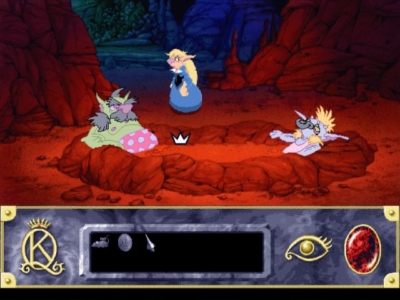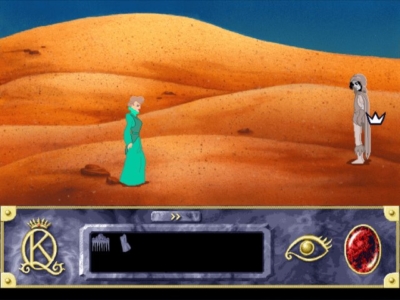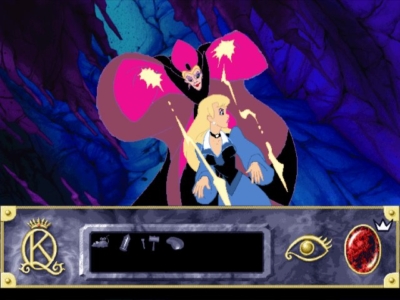
King’s Quest VII: The Princeless Bride
Written by: Jo
Date posted: May 27, 2012
- Genre: Adventure
- Developed by: Sierra
- Published by: Sierra
- Year released: 1995
- Our score: 6
I’ve been promising this review for about three years now, and last year I finally got around to sitting down and playing through the game. I got pretty far – four chapters in to a six chapter game – and then it crashed before I’d saved and I was so angry I didn’t pick it up again until now. Well, that’s not entirely true. Various life things popped up and, as ever, some things just take priority over retracing your steps through a couple of hours of gameplay. But I have been wondering why it’s taken me so long to pick up from where I left off and I think it has something to do with midi flutes, rainbows and surprising deaths – the latter being a classic feature of most Sierra adventures.
The danger with any long running series, of films or games, is there comes a point where the audience needs to expand beyond its current fan base. As an example, how many times have you seen one of many sequels in a series of films and asked: “Is this going to make sense if I haven’t seen the other films?” Sierra were six games into the KQ series when they reached such a predicament. Six games is a lot to catch up on story-wise, so KQVII had to appeal to newcomers who would be able to play through the game without feeling totally lost in the story, as well as loyal KQ fans who knew the story-so-far inside out.
As a result, there are a few significant differences which set apart KQVII from its predecessors (not including the dazzling graphics and Disney-inspired animation). The first is that unlike the previous KQ games, the story doesn’t take place in the Kingdom of Daventry, nor does it feature King Graham. Instead, KQVII enthusiastically turns up the volume on its fantasy roots, and transports us into another realm – the Kingdom of Eldritch. The second key difference is that the game is divided into six chapters. Each chapter is set in a different part of Eldritch. As the player moves through the chapters they alternate between the two protagonists – Princess Rosella and her mother Queen Valanice (who both appeared in the earlier games). By introducing new protagonists and a new location the story is both open to a potential new audience, yet it remains faithful to the story so far. But the question here isn’t just ‘did the game succeed in appealing to both audiences?’ it’s more ‘how does it succeed as an adventure game?’
Cue intro – a visually stunning cut scene where we’re introduced to one of our two protagonists: Princess Rosella who, in eerily Disney-fashion (it’s like A Whole New World on speed), is singing about how she doesn’t want to get married and wants to escape to a world full of enchantment and adventure. Cut to Rosella discussing the matter further with our second protagonist, her (extremely English) mother, Queen Valanice of Daventry who is trying to convince her daughter to go on a hot date with Prince Frogmorton. ‘But I just want to have fun!’ squeaks Rosella, sulking by a pond where she is distracted by a flying seahorse. In the distance her mother prattles on about the importance of marriage and ‘settling down’ and that old Frogmorton might just be the chap for her. Repulsed by the idea, Rosella does the only thing any girl in her position would do. She jumps into a pond.
‘OMG!’ says Valanice (not really), staring into the pond – now a swirling vortex – and then she jumps in too, only to find that Rosella has been snatched away by a mysterious hand that reaches from the vortex. Valanice is then transported off to a remote desert, where the game begins. Your quest is for Rosella and Valanice to find one another and return home…and also solve all the problems of everyone you meet because all of Eldritch is at the evil clutches of Malicia – a sorceress dressed like Jafar from Disney’s Aladdin (with an equally deep voice).
We begin our quest as Valanice in the desert, but this is just one of many locations: we go to a nightmarish, Halloween land called Ooga Booga, a volcanic underground filled with trolls, a tranquil meadow governed by a talking poodle and a sky-world filled with unicorns and rainbows (no, really). This is one of the things I really like about the game, it’s a patchwork of different fantasy worlds within one realm – a contrast of light and dark, colour and monochrome, cheerful and foreboding, yet always promoting that sense of ‘otherness’ in a fantasy world. And no alternate world would be complete without an atmospheric (albeit midi) soundtrack…
The haunting tones of the underworld and desert are the most atmospheric, whereas the twee skipping flutes of rainbowland etc. can become increasingly irritating. The sweet pleasantry has been turned up to eleven, and there’s no escaping it. Well, actually there is – as (much to my horror) I only discovered I could turn the music volume down after I’d finished the game which means I can’t rant about how annoying I found it that sometimes the dialogue was drowned out by the aggressively persistent midi flutes. That said, the accompanying music to the desert chapter effectively evoked a sense of isolation.
I’ve already mentioned that the intro is very visually stunning even now (17 years later) and the rest of the game follows in much the same vein. The backdrops are genuinely striking, and the characters (whilst being incredibly slow at walking from one end of the screen to the other) are wonderfully animated. You’d be forgiven for suspecting that this seventh instalment was all pretty, Disney graphics with very little substance and while that certainly isn’t the case here – there’s plenty of story and puzzles to go at – there is something holding me back from really, really liking it.
My biggest problem with KQVII is the infuriating barriers that pop up purely for the sake of it. Throughout the game, meaningless hurdles seem to have been thrown in to slow you down but without any discernible reason. In the first chapter, for example, Valanice has to walk through a totally empty (i.e. there’s nothing to interact with) desert, but there are no hints as to which direction takes you back to civilisation. Randomly clicking from one screen to the next might work, or it might not and you will die (or ‘expire’ as Sierra put it). In another part of the game you need to use an elevator to get into a treehouse – but you can only use the elevator if it’s there waiting for you. If it isn’t, you have to wander on and off the screen until it appears. I don’t understand why these have been included, it’s not as though there’s any real logic behind it (as in you have to complete puzzle x before you can start puzzle y) because you literally just wait around until the elevator appears, or until you return from the desert. These slow down the progression – it’s as though the developers were trying to slow the pace down, or mislead the player somehow, but why? KQVII is by no means a short game filled with easy puzzles.
In fact, there’s a mixed bag of puzzles here, ranging from the cryptic to the simple, and a fair few which have multiple right answers – your choice of how to solve the puzzles dictates how you will solve future puzzles and so on. However, some of the puzzles are devoutly faithful to adventure-logic – in one part of the game you place ambrosia (not the Devon custard) in a conch which causes it to turn into fruit, from which you select a pomegranate, to give to a some guy with a beard who uses it to turn a tree back into a person. Seriously now, a pomegranate – who came up with that? I mean, I know they’re rich in antioxidants, but it seems a tad farfetched – even for fantasy game. I was more comfortable with the jumping in the pond/vortex thing at the beginning.
Another speed bump comes in the form of the occasional death here and there. I’ve never really seen the point in deaths in adventure games. Adventure deaths slow the pace down, and its especially pointless in KQVII, because after you ‘expire’ you simply ‘try again’ and you go right back to the point at which you died. What’s more, it’s the lack of consistency that frustrates me (falling off the edge of a cliff won’t kill you, but walking through a desert for a few minutes will) – if the death traps aren’t going to make sense, then they should at least be consistent in their nonsense.
The interface has been simplified from previous KQ games, taking a more ‘point and click’ approach to gaming. The cursor takes the form of a wand – a useful device that flashes over any object you can actually interact with. This is particularly useful when the scenery and objects blend so well together – it’s sometimes tricky to tell simply by looking, what you can interact with.
The action takes place in the main window, with the inventory occupying a box in the bottom of the screen. This consists of an eye (to examine objects in your inventory more closely), a stone (for game options) and a large, ostentatious ‘K’ (which serves no purpose). F5 brings up the save/load menu – or ‘Bookmark Options’. Just a minor point here, but KQVII has only one save slot – known as a ‘bookmark’ – meaning you can only ever save to the same one slot. It’s very limiting, especially in a game that has multiple plot threads and solutions to puzzles and, of course, spontaneous deaths.
KQVII has a strong, complex narrative – the puzzles are an even mix of simple tasks and full-on head-scratchers which are evenly distributed across the game giving it a good pace – which is why I find the progression barriers so infuriating. There are a diverse range of locations to explore, all beautifully designed, giving real texture and depth to the game. Alternating between the two main characters also allows a change in perspective of the story, whilst also giving the player the ability to explore new places and meet new characters. And while KQVII isn’t without its technical glitches and animation hang-ups, it is still a very engaging, playable game that won’t have you reaching for the walkthrough too often. That said, I didn’t love it, and I’m not sure if that’s simply because I generally struggle with the fantasy genre, or whether it’s lacking that slightly more endearing, humorous element of other adventure games. Or maybe I would have liked it more if I’d realised I could turn the volume down on the midi flutes.






 Posts
Posts